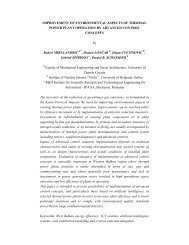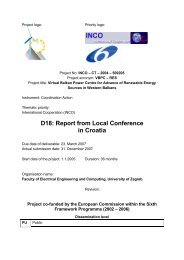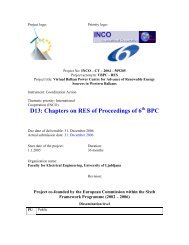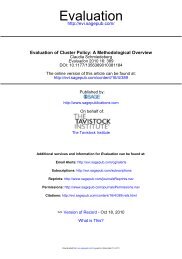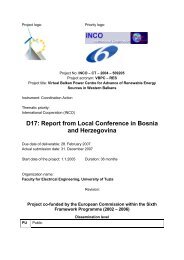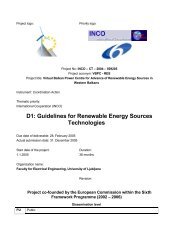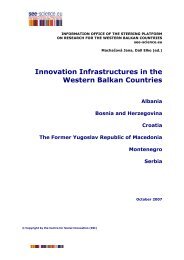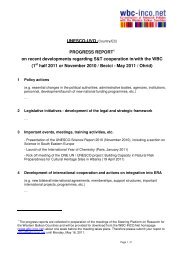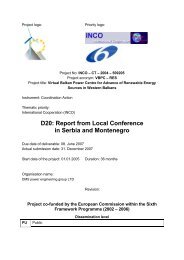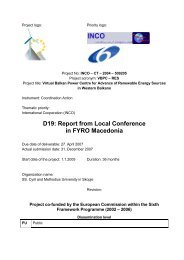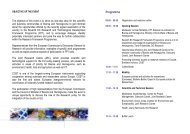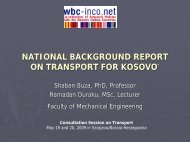Catalogue of Research Groups from Moldova - WBC-INCO Net
Catalogue of Research Groups from Moldova - WBC-INCO Net
Catalogue of Research Groups from Moldova - WBC-INCO Net
You also want an ePaper? Increase the reach of your titles
YUMPU automatically turns print PDFs into web optimized ePapers that Google loves.
SEVENTH FRAMEWORK<br />
PROGRAMME<br />
THE NATIONAL MUSEUM OF ETHNOGRAPHY AND NATURAL HISTORY OF<br />
MOLDOVA<br />
Organization activity type : RES<br />
FP7 theme : SSh<br />
Contact person : Dr. Mihai Ursu<br />
Address : Trade Cooperative University <strong>of</strong> <strong>Moldova</strong><br />
82, M. Kogalniceanu Street<br />
MD 2009, Chisinau<br />
Republic <strong>of</strong> <strong>Moldova</strong><br />
E-mail : mnein_posta@yahoo.com<br />
Web : www.museum.md<br />
BRIEf dESCRIpTIon <strong>of</strong> ThE oRganIzaTIon<br />
The institution was created in 1889. It has 22 researchers, <strong>of</strong> which 12 are Doctors <strong>of</strong> Science. The Museum administers<br />
about 150.000 museum pieces. The main scientific contributions are reflected in : “The Scientific Bulletin. Review <strong>of</strong><br />
Ethnography”, “Natural Science” and “Museology”.<br />
During the last 5 years the institution has edited 12 monographs, 5 text-books, as well as 145 articles in national<br />
reviews and published 47 articles in international publications.<br />
KEywoRdS on CoRE CompETEnCIES<br />
Mobile cultural heritage; intangible cultural heritage; traditional culture; natural heritage; preserve.<br />
ExpERTISE / CompETEnCIES / TEChnologIES / RTd Know-how<br />
• Scientific research on the conceptualized new direction Ethno-ecological <strong>Research</strong>es in Republic <strong>of</strong><br />
<strong>Moldova</strong>; • A number monasteries and unknown stone monasteries were identified on the territory<br />
between Bug and Nistru rivers which completes the way <strong>of</strong> spreading Christianity in Eastern Europe.<br />
• Two wooden churches were restored and conserved : Palanca, Calarasi (XVIIth Century) and the<br />
Church <strong>from</strong> Hiriseni, Telenesti (XVIIIth Century); • A draft Law on Protection <strong>of</strong> the Intangible<br />
Cultural Heritage; • The National Strategy <strong>of</strong> <strong>Moldova</strong> - to safeguard the intangible cultural heritage <strong>of</strong><br />
<strong>Moldova</strong>.<br />
InTERnaTIonal CoopERaTIon ExpERIEnCE<br />
• National Inventory <strong>of</strong> the Intangible Cultural Heritage <strong>of</strong> <strong>Moldova</strong> in accordance with the 2003<br />
International Convention for the Safeguarding <strong>of</strong> the Intangible Cultural Heritage, 2010; • “Ethnic<br />
Consciousness in <strong>Moldova</strong>” Academy <strong>of</strong> Sciences, Vienna, Austria, 2010. AOS - Atlas <strong>of</strong> Eastern and<br />
Southeastern Europe. Up-to-date ecological, demographic and economic maps; • Economy and Ritual<br />
Study in <strong>Moldova</strong>, Max-Plank Institute for Social Anthropology, Halle, Germany, 2010; • National<br />
Training “The Museum Management”, 2009, UNESCO Moscow Office. • “UNESCO Conventions in<br />
the field <strong>of</strong> protection <strong>of</strong> cultural heritage in correlation with the national legal framework”, Ministry <strong>of</strong><br />
Culture MNEIN and UNESCO Moscow Office, 2009; • “The Folklore and Contemporaneity”, 2006;<br />
• „Ethno-historic-demographic maps”, 2010, Chisinau. • “Water : History, Resources, Perspectives”,<br />
2010, the science academies <strong>from</strong> : <strong>Moldova</strong>, Romania,and Austria; • “Cultural exclusion in <strong>Moldova</strong>”<br />
(part <strong>of</strong> the Report <strong>of</strong> Human Development on Social Inclusion in Europe and CSI), 2010.<br />
73



